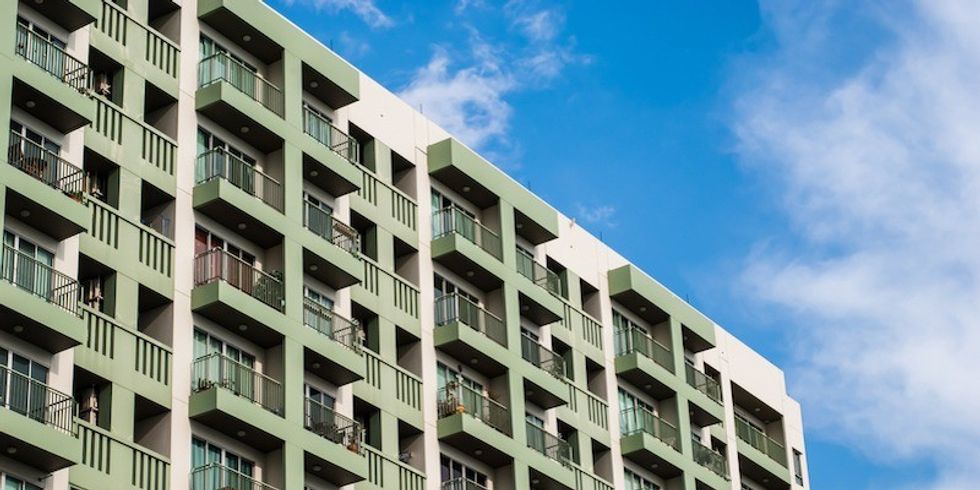The only thing more discouraging than sky-high real estate costs in Canada’s biggest cities is the cost of rent. But the Liberal Party wants to help with a federal rent-to-own program.
Especially in cities like Toronto and Vancouver, rent prices are disproportionate to incomes and make saving precious pennies for a down payment on a home all the more difficult (see: unattainable for most, to the point that young people are giving up).
And, after a pandemic-inspired drop in rent prices, Canada’s rental market has bounced right back to life -- rather suddenly becoming as pricey as ever.
The average rent for all Canadian properties listed on Rentals.ca in July 2021 was $1,752 per month, up 1.8% month-over-month. While in the Greater Toronto Area (GTA), average rents in July increased month-over-month by 3% to $2,078, with Toronto experiencing the largest monthly increase at 4.7% (to $2,167). This, according to the latest Toronto GTA Rent Report from Bullpen Research & Consulting and TorontoRentals.com.
RELATED: Smoke and Mirrors or A for Effort? Liberal Housing Strategy Divides Experts
Meanwhile, the average price of a Toronto home (across all types) found itself north of a million dollars in July, landing at an overwhelming $1,016,580.

Naturally, Canada’s affordable housing crisis is front and centre on campaign platforms as the country approaches its September 20th federal election. And so, in a headline-making move to help renters get ahead (in theory, at least), the Liberal Party announced the easy-on-the-ears federal Rent-to-Own program last month.
Through the initiative $1 billion in loans and grants are intended to make life easier for renters looking to one day become homeowners. Essentially, the program turns a proportion of rent paid into savings.
“We will commit $1 billion in loans and grants to develop and scale up rent-to-own projects with private, not-for-profit, and co-op partners,” reads the Liberal Party’s website. “Under a typical rent-to-own model, an individual commits to renting a property for a period of time with the option of buying it at a locked-in price before the end of the lease, to allow them to save for a down payment.”
Under the plan, the government will work with their partners to ensure they are able to set aside a portion of new housing stock for rent-to-own purposes. The Liberals say they will create a stream for current renters and landlords, particularly those in condo settings, to immediately enter into a rent-to-own program.
According to the Liberals’ website, the program will function based on three principles: the landlord must commit to charging a renter a lower-than-market rate to help Canadians build up savings for a down payment; the landlord must commit to ownership in a five-year term or less; and proper safeguards will be in place to protect the future homeowner.
Regardless of political views, many would agree that a federal rent-to-own plan like this is overdue in our current housing market -- at first glance, at least.
But will the rent-to-own plan even make a dent when it comes to tackling housing affordability? Or does it just sound like a nice idea?
The problem with the program, say some experts, is that it zeroes in on a niche group of future homebuyers who are already close to seeing their dreams of homeownership materialize. Furthermore, they say it does little to get to the root of the housing affordability issue.

According to Ricardo Tranjan, a senior researcher with the Canadian Centre for Policy Alternatives, many of the housing policies proposed by Canada’s leading political parties may sound promising at first but will have little impact for the vast majority of Canadian families when it comes to housing affordability.
“The Liberals' proposed rent-to-own plan is a typical example,” says Tranjan. “Like other measures focused on first-time homebuyers, it may help some families to get through the last mile of the race by providing a bit of financial support. The problem is that most tenant families are nowhere near that last mile. Actually, a large share is not in the race at all.”
Tranjan calls rent-to-own programs “at best, a final push” for some families. The vast majority of tenant families, however, will never qualify for such program, he says.
“Rent-to-own programs allow buyers to lock in a property early, carefully negotiate a mortgage, and save a bit on the down payment. In today’s housing market, given how much is needed for a down payment on even average homes, rent-to-own plans are not a deal-breaker,” says Tranjan.
Given that, relative its actual impact, Tranjan calls the scheme “an inherently complicated program involving all sorts of partnerships with other governments and private developers”, he and fellow opponents believe the federal dollars are best spent elsewhere.
“Chances are, this would be yet another boutique housing program that helps a small number of upper-middle-income families and does nothing for low and moderate-income renters,” says Tranjan. “We’ve had many of these programs in Canada; we can do without another one.”
(Just look to the first-time homebuyers incentive for a perfect example of how badly some of these programs can go.)
Furthermore, committing to such a program may actually stretch some of the rent-to-own buyers thin financially and actually have a counter effect when it comes to housing affordability.
“From a general perspective, I feel that rent-to-buy sounds like a great way for current renters to get into the market... but it’s definitely not going to make housing more affordable and could actually add to the cost of housing,” says Diana Petramala, Senior Economist, Centre for Urban Research and Land Development at Ryerson University. “Furthermore, it could end up costing them more too -- kind of like how car leases seem attractive on a monthly basis but are fairly expensive.”

John Dickie, President of the Canadian Federation of Apartment Associations, shared the sentiment.
“This program could mean the government may put, say, $200 to $400 in to bridge the gap between what the market is and what the tenant can more comfortably afford,” says Dickie. “But when we say that, then we are talking about an affordability problem. So, if we spent that money to help them with their affordability problem, that would do more good for them for the next several years rather than helping them take on an extra obligation.”
So far, key details regarding the program -- the specific allocation of federal funds and how the federal government would work with municipalities, for example -- haven’t been made public.
“A lot of the benefits and usefulness of rent-to-own programs depend on the details,” says Petramala, “For instance, will there be a required deposit? Who will build the units and what type of units will be subject to the rent-to-buy rules? How will the purchase price be determined?”
Petramala says she’s not surprised it took a while for the idea of federally-funded rent-to-own programs to be introduced in Canada. “I think they work in a market where home prices relative to rents are excessively high and real estate prices are only expected to rise at a rapid pace, otherwise, the risk/benefit analysis doesn't work in these programs’ favour,” she says.
READ: Developer’s $1B Residential Housing Buy Up Could Be Just the Beginning
Petramala points to the hindrance of sky-high and sharply rising rents on the ability to save. “That in itself may be the factor that makes these programs more beneficial in this current environment,” she says. “And forecasts are less and less calling for a correction in home prices, so the belief that prices are going to go up forever may also make these programs work more in the favour of the renter/buyer.”
While the program may sound attractive to renters looking to become homeowners, Dickie questions the willingness of landlords to participate in the program.
“I don’t think it’s a bad thing to do; I don’t think it will create harm; particularly the support for the non-profit suppliers could help them expand their operations. I don’t think it will help on the private market side,” says Dickie. “Why would I, as a private market developer of houses, want to charge a lower than market value rent than I could get in the community? Frankly, what’s in it for me?”
Tranjan says that the crucial debate on housing is how to make renting a viable alternative -- not funding for a limited number of rental units that aren’t actually affordable, or about initiatives to assist prospective homebuyers that actually serve to increase demand in an already overheated market.
“Neither of these will help tenants who need rents that don’t rise faster than inflation and wages (in occupied and vacant units), landlords who maintain units in a good state of repair, and protection against arbitrary evictions,” says Tranjan.
Dickie points to Canada’s supply issue as the big problem on the affordable housing crisis front. Our supply shortage is due to everything from an aging population and increased immigration to a relative lack of new homes being built compared to in the past, due to increasing development demands and costs, says Dickie.
“We need to speed up development approvals, loosen land restrictions like the Green Belt and zoning requirements around Toronto, and reduce the cost of development,” says Dickie. “If it was cheaper to develop, then there would be more supply and prices would be lower.”
On the federal government side -- though he acknowledges that immigration is undoubtedly a positive thing -- Dickie suggests we untangle our current housing crisis before welcoming a large influx of new immigrants.
While Petramala doesn’t think that rent-to-own programs are without their merits -- notably, the theoretical income boost to lower income households -- she says that such demand-side strategies won’t do anything to restore balance in the market so that household incomes can rise at a faster rate than shelter costs. To balance the market, she points to a need to either reduce demand or boost supply in the near term.
“The Feds have already tried some supply-side incentives through the NHS, but the expensive nature of markets have made take-up of these programs slow,” says Petramala. “Bigger tax breaks for developments, money for municipalities to absorb population and economic growth, or tying municipal infrastructure spending to planning objectives (somewhat seen in the conservative platform) is a step that might help support more development.”
The Liberal Party’s housing plan also includes measures to curb "flipping" homes, the banning of "blind bidding," a promise to double the first-time homebuyers tax credit, and a two-year pause on home purchases by non-resident foreign investors.





















